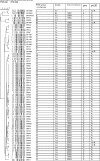Pulsed-field gel electrophoresis, pertactin, pertussis toxin S1 subunit polymorphisms, and surfaceome analysis of vaccine and clinical Bordetella pertussis strains
- PMID: 17699837
- PMCID: PMC2168178
- DOI: 10.1128/CVI.00177-07
Pulsed-field gel electrophoresis, pertactin, pertussis toxin S1 subunit polymorphisms, and surfaceome analysis of vaccine and clinical Bordetella pertussis strains
Abstract
To add new insight to our previous work on the molecular epidemiology of Bordetella pertussis in Argentina, the prn and ptxS1 gene sequences and pulsed-field gel electrophoresis (PFGE) profiles of 57 clinical isolates obtained during two periods, 1969 to 1989 and 1997 to 2006, were analyzed. Non-vaccine-type ptxS1A was detected in isolates obtained since 1969. From 1989 on, a shift of predominance from the vaccine prn1 type to the nonvaccine prn2 type was observed. This was also reflected in a transition of PFGE group IV to group VI. These results show that nonvaccine B. pertussis strains are currently circulating. To analyze whether the observed genomic divergences between vaccine strains and clinical isolates have functional implications, protection assays using the intranasal mouse challenge model were performed. For such experiments, the clinical isolate B. pertussis 106 was selected as representative of circulating bacteria, since it came from the major group of the PFGE dendrogram (PFGE group VI). Groups of mice were immunized either with diphtheria-tetanus-whole-cell pertussis vaccine (ptxS1B prn1) or a vaccine prepared by us containing B. pertussis 106. Immunized mice were then challenged with a B. pertussis vaccine strain (Tohama, harboring ptxS1B and prn1) or the clinical isolate B. pertussis 106 (ptxS1A prn2). An adequate bacterial-elimination rate was observed only when mice were immunized and challenged with the same kind of strain. For further characterization, comparative proteomic profiling of enriched membrane proteins was done using three vaccine strains and the selected B. pertussis 106 clinical isolate. By matrix-assisted laser desorption ionization-time of flight mass spectrometry analysis, a total of 54 proteins were identified. This methodology allowed us to detect differing proteins among the four strains studied and, in particular, to distinguish the three vaccine strains from each other, as well as the vaccine strains from the clinical isolate. The differing proteins observed have cellular roles associated with amino acid and carbohydrate transport and metabolism. Some of them have been proposed as novel vaccine candidate proteins for other pathogens. Overall, the global strategy described here is presented as a good tool for the development of next-generation acellular vaccines.
Figures


Comment in
-
Bordetella pertussis polymorphism and pertussis vaccines.Clin Vaccine Immunol. 2008 Feb;15(2):394; author reply 394-5. doi: 10.1128/CVI.00391-07. Clin Vaccine Immunol. 2008. PMID: 18245622 Free PMC article. No abstract available.
Similar articles
-
Antigenic divergence suggested by correlation between antigenic variation and pulsed-field gel electrophoresis profiles of Bordetella pertussis isolates in Japan.J Clin Microbiol. 2004 Dec;42(12):5453-7. doi: 10.1128/JCM.42.12.5453-5457.2004. J Clin Microbiol. 2004. PMID: 15583264 Free PMC article.
-
Sequence variation in pertussis S1 subunit toxin and pertussis genes in Bordetella pertussis strains used for the whole-cell pertussis vaccine produced in Poland since 1960: efficiency of the DTwP vaccine-induced immunity against currently circulating B. pertussis isolates.Vaccine. 2004 Jun 2;22(17-18):2122-8. doi: 10.1016/j.vaccine.2003.12.006. Vaccine. 2004. PMID: 15149768
-
Colonization of Bordetella pertussis clinical isolates that differ by pulsed field gel electrophoresis types in the lungs of naïve mice or mice immunized with the whole-cell pertussis vaccine used in Poland.Arch Immunol Ther Exp (Warsz). 2015 Apr;63(2):155-60. doi: 10.1007/s00005-014-0314-x. Epub 2014 Oct 9. Arch Immunol Ther Exp (Warsz). 2015. PMID: 25297678
-
Bordetella pertussis and pertactin-deficient clinical isolates: lessons for pertussis vaccines.Expert Rev Vaccines. 2014 Sep;13(9):1135-46. doi: 10.1586/14760584.2014.932254. Epub 2014 Jun 23. Expert Rev Vaccines. 2014. PMID: 24953157 Review.
-
Molecular Epidemiology of Bordetella pertussis.Adv Exp Med Biol. 2019;1183:19-33. doi: 10.1007/5584_2019_402. Adv Exp Med Biol. 2019. PMID: 31342459 Review.
Cited by
-
Genome-wide gene expression analysis of Bordetella pertussis isolates associated with a resurgence in pertussis: elucidation of factors involved in the increased fitness of epidemic strains.PLoS One. 2013 Jun 11;8(6):e66150. doi: 10.1371/journal.pone.0066150. Print 2013. PLoS One. 2013. PMID: 23776625 Free PMC article.
-
Bordetella pertussis Isolates from Argentinean Whooping Cough Patients Display Enhanced Biofilm Formation Capacity Compared to Tohama I Reference Strain.Front Microbiol. 2015 Dec 8;6:1352. doi: 10.3389/fmicb.2015.01352. eCollection 2015. Front Microbiol. 2015. PMID: 26696973 Free PMC article.
-
Bordetella Pertussis virulence factors in the continuing evolution of whooping cough vaccines for improved performance.Med Microbiol Immunol. 2018 Feb;207(1):3-26. doi: 10.1007/s00430-017-0524-z. Epub 2017 Nov 21. Med Microbiol Immunol. 2018. PMID: 29164393 Review.
-
Genetic Variation of Bordetella pertussis in Austria.PLoS One. 2015 Jul 16;10(7):e0132623. doi: 10.1371/journal.pone.0132623. eCollection 2015. PLoS One. 2015. PMID: 26182210 Free PMC article.
-
Mass spectrometric analysis of multiple pertussis toxins and toxoids.J Biomed Biotechnol. 2010;2010:942365. doi: 10.1155/2010/942365. Epub 2010 May 23. J Biomed Biotechnol. 2010. PMID: 20508854 Free PMC article.
References
-
- Andrews, R., A. Herceg, and C. Roberts. 1997. Pertussis notifications in Australia, 1991 to 1997. Commun. Dis. Intell. 21:145-148. - PubMed
-
- Artenstein, M. S., B. L. Brandt, E. C. Tramont, W. C. Branche, Jr., H. D. Fleet, and R. L. Cohen. 1971. Serologic studies of meningococcal infection and polysaccharide vaccination. J. Infect. Dis. 124:277-288. - PubMed
-
- Bradford, M. M. 1976. A rapid and sensitive method for the quantitation of microgram quantities of protein utilizing the principle of protein-dye binding. Anal. Biochem. 72:248-254. - PubMed
-
- Brook, I., P. A. Foote, and J. N. Hausfeld. 2006. Frequency of recovery of pathogens causing acute maxillary sinusitis in adults before and after the introduction of vaccination of children with the 7-valent pneumococcal vaccine. J. Med. Microbiol. 55:943-947. - PubMed
Publication types
MeSH terms
Substances
LinkOut - more resources
Full Text Sources
Other Literature Sources

